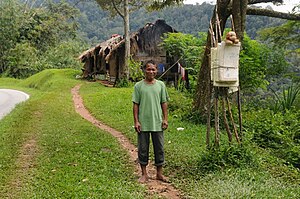Suku Semai
Suku Semai (juga dikenal sebagai Mai Semai atau Orang Dalam[2]) adalah kelompok etnis semi-menetap yang tinggal di tengah Semenanjung Malaka di Malaysia, yang dikenal terutama karena budaya antikekerasan mereka.[3] Mereka menuturkan bahasa Semai, sebuah bahasa Austroasiatik yang terkait erat dengan bahasa Temiar, yang dituturkan oleh suku Temiar yang tinggal di dekatnya. Suku Semai berbatasan dengan suku Temiar di utara dan Jah Hut di selatan.[4] Suku Semai termasuk dalam kelompok Senoi, dan merupakan salah satu kelompok etnis pribumi terbesar di Semenanjung dan yang terbesar dari kelompok Senoi. Suku Semai sebagian besar hidup dengan bercocok tanam biji-bijian, berburu, dan memancing.
 | |
| Jumlah populasi | |
|---|---|
| 49.697 (2010)[1] | |
| Daerah dengan populasi signifikan | |
| Bahasa | |
| Semai, Melayu | |
| Agama | |
| Animisme, Kekristenan, dan Islam | |
| Kelompok etnik terkait | |
| Temiar, Lanoh, Jah Hut, Khmer, Jawa |
Populasi
Dinamika kependudukan suku Semai di Malaysia:
| Tahun | 1960[5] | 1965[5] | 1969[5] | 1974[5] | 1980[5] | 1991[6] | 1993[6] | 1996[5] | 2000[7] | 2003[7] | 2004[8] | 2010[1] |
|---|---|---|---|---|---|---|---|---|---|---|---|---|
| Populasi | 11.609 | 12.748 | 15.506 | 16.497 | 17.789 | 28.627 | 26.049 | 26.049 | 34.284 | 43.892 | 43.927 | 49.697 |
Di semua kelompok umur, populasi pria cenderung melebihi populasi wanita, yang mungkin karena tingginya angka kematian ibu melahirkan.[9]
Referensi
- ^ a b Kirk Endicott (2015). Malaysia's Original People: Past, Present and Future of the Orang Asli. NUS Press. hlm. 3. ISBN 978-99-716-9861-4.
- ^ Ivor Hugh Norman Evans (1968). The Negritos of Malaya. Cass. ISBN 0-7146-2006-8.
- ^ Csilla Dallos (2011). From Equality to Inequality: Social Change Among Newly Sedentary Lanoh Hunter-Gatherer Traders of Peninsular Malaysia. University of Toronto Press. ISBN 978-144-2661-71-4.
- ^ Dentan, Robert Knox (1968). "The Semai: A Nonviolent People Of Malaya". Case Studies In Cultural Anthropology.
- ^ a b c d e f Nobuta Toshihiro (2009). "Living On The Periphery: Development and Islamization Among Orang Asli in Malaysia" (PDF). Center for Orang Asli Concerns.
- ^ a b Colin Nicholas (2000). The Orang Asli and the Contest for Resources. Indigenous Politics, Development and Identity in Peninsular Malaysia (PDF). Center for Orang Asli Concerns & International Work Group for Indigenous Affairs. ISBN 87-90730-15-1.
- ^ a b "Basic Data / Statistics". Center for Orang Asli Concerns.
- ^ Alberto Gomes (2004). Modernity and Malaysia: Settling the Menraq Forest Nomads. Routledge. ISBN 11-341-0076-0.
- ^ Dentan, R. K., & Skoggard, I. A. (2012). Culture Summary: Semai. New Haven: Human Relations Area Files. Retrieved from https://ehrafworldcultures.yale.edu/document?id=an06-000
Bacaan lebih lanjut
- Orang Asli Archive, Keene State College .
- Dentan, Robert Knox, 1968, The Semai: A Nonviolent People of Malaya, Holt, Rinehart and Winston, ISBN 0-03-069535-X; repr. 1979 as Fieldwork Edition, Case Studies in Cultural Anthropology, New York, Holt, Rinehart and Winston.
- De Waal, Frans, 2005, Our Inner Ape: A Leading Primatologist Explains Why We Are Who We Are, Riverhead Books.
- Bonta, Bruce D. 1997. "Cooperation and Competition in Peaceful Societies." Psychological Bulletin 121(2):299-320.
Pranala luar
- http://projekt.ht.lu.se/rwaai RWAAI (Repository and Workspace for Austroasiatic Intangible Heritage)
- http://hdl.handle.net/10050/00-0000-0000-0003-66BF-5@view Semai in RWAAI Digital Archive